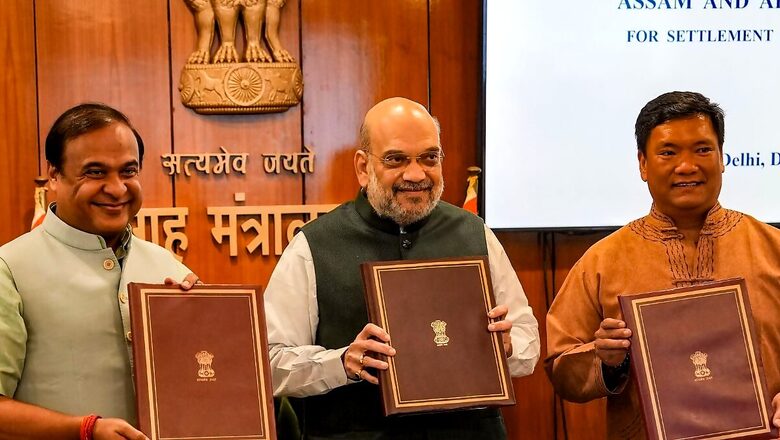
views
The Assam and Arunachal Pradesh governments signed a memorandum of understanding (MoU) on Thursday in New Delhi to end a decades-long border dispute.
Arunachal Pradesh chief minister Pema Khandu and his Assam counterpart Himanta Biswa Sarma had several rounds of meetings to address the boundary issue. They signed the final agreement in the presence of union home minister Amit Shah.
How it was done
Both states had formed regional committees that had made proposals to address the long-pending issue.
This is being seen as a big success for the BJP in the Northeast ahead of the 2024 Lok Sabha elections.
Solving interstate border disputes has been the Centre’s priority and a 2019 poll promise.
Why it is important
Arunachal Pradesh and Assam share an around 804-km-long boundary. A suit had been pending in the Supreme Court on the issue since 1989.
The matter dates back to 1972 when NEFA (Northeast Frontier Agency) was declared a union territory. In 1987, NEFA became Arunachal Pradesh. Arunachal then claimed most of the forest region at the border that was then under Assam.
The challenges
In April 1979, a high-powered tripartite committee was constituted to delineate the boundary on the survey of India maps.
While around 489 km of the 804 km was demarcated by 1983-84, further exercise couldn’t take place because Arunachal didn’t accept the recommendations.
It claimed a large chunk of the 3,648 sq km, which had been transferred to Assam in line with the 1951 report.
Assam objected to this and filed a case in the Supreme Court in 1989, highlighting the “encroachment” by Arunachal Pradesh.
To resolve this between the two states, the top court appointed a local boundary commission in 2006, headed by a retired SC judge.
The findings were submitted in September 2014. However, there was no consensus between the two states.
In 2021, Prime Minister Narendra Modi underscored the importance of solving the interstate border disputes of the Northeast as a key agenda of his government, and union home minister Amit Shah and the two states resolved to settle the border dispute out of court through talks.
Namsai Declaration
In July last year, both states signed the Namsai Declaration, in which it was agreed to bring down the number of disputed villages from 123 to 86 and resolve the boundary row by forming 12 committees each headed by cabinet ministers that visited disputed areas, took feedback from residents, and submitted reports.
Consequences of the interstate border dispute
As per estimates, over 160 people died between 1979 and 2022 in border disputes between Assam and neighbouring states carved out of it, including Arunachal Pradesh, Meghalaya, Mizoram, and Nagaland. Additionally, over 370 people were injured in such incidents during the period, which also saw the displacement of more than 75,000 people.
The most recent incident of border violence leading to the killing of six people near a disputed stretch at the Assam-Meghalaya border in November last year disrupted the talks between the two states.
What will change and what won’t
One village in Arunachal Pradesh as per the notified boundary will be included in Assam. 60 villages in Assam will now be counted as part of Arunachal Pradesh.
No changes will be seen in 10 disputed villages in Assam. The issue of the rest of the disputed villages will be decided in the next few months.
Read all the Latest India News here


















Comments
0 comment